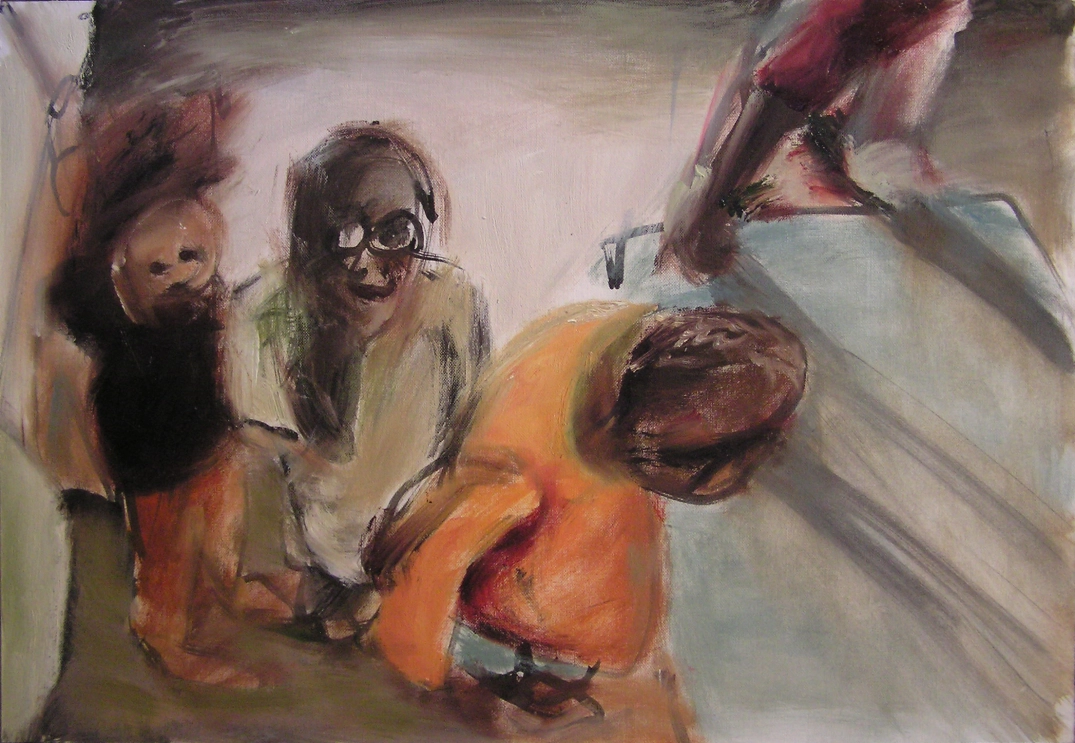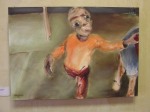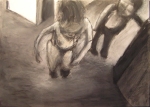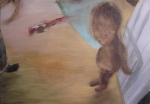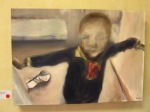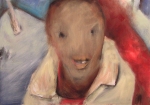Rites of Passage
‘Rites of Passage’ is an interpretation of my personal experience. The questions that arose from this experience correspond directly to the effects of a dysfunctional society, as well as to the effects of my own dysfunctions.
A Rite of Passage usually denotes a major change in one’s life, tied up with a number of often contrasting and confusing emotions. A certain amount of pain and discomfort is an inevitable part of the process of maturation and growth, and the official opinion seems to be that we can, under normal conditions, cope with and assimilate such growing pains. But just exactly what constitutes normal conditions?
I believe that the line between ‘normal’ and ‘abnormal’ is blurred at best and indistinguishable at worst, as each individual experiences emotion differently.
What is traumatic for one person might be less so for another.
Yet there is an unspoken consensus that when trauma exists, coping and assimilating becomes either a lifelong task or a permanent wound in the psyche.
Victims of physical, sexual, and emotional abuse are forced to undergo a distorted Rite of Passage, and in the case of children usually long before it would have occurred ‘naturally’. The damaging effects of such trauma are indisputable. What I am querying is our responsibility, or lack thereof, as individuals and a society, towards such children: Should they be helped, can they be helped, will they be helped?
Is their premature loss of childhood innocence a hurt that will never be healed no matter how many well-meaning sponsors get involved? Are the wounds of life there for a purpose, and must therefore be endured?
Are the perpetrators of abuse merely victims of their own unresolved trauma? At which point in the cycle should the need for accountability arise?
Do you hold yourself accountable for your own dysfunctional actions?
The monstrosity of what human beings are capable of is not something I can or want to judge. I can only observe the ongoing negation of each and every one of the ideals that supposedly elevate us to an “advanced” level of evolution. The distortion and abuse that revered ideal such as ‘love’ ‘respect’ ‘truth’ ‘goodness’ etc. suffer from, as evident in the massive occurrence of abuse, murder, rape, theft, corruption, and divorce, suggests rather that humanity, despite its delusion of advancement throughout the ages, still prefers to adapt these ideals to its behaviour rather than its behaviour to the pursuit of ideals.
Excerpt from a review of the exhibition by John Sampson:
The Silke Berens exhibition, “Rites of Passage” at the Omba Gallery is a disturbing show. The title is an immediate hint that this is not your run-of-the-mill themed showing of pleasant works. The theme of this exhibition is quite the opposite, dealing as it does with child-abuse, not a popular area of focus.
But artists are not immune to the aberrations in society and it behoves them to comment on the ruptures in our moral/ethical structures, and the value systems that should be cultivated in our homes and families. It is precisely in this so-called comfort zone that children are abused, and Silke Berens speaks about this in her work.
Good exhibitions, invariably, speak to one at the visual level, this one does that, but more so, it sits in the throat, because it makes no excuse for its confrontational aspects. Child-abuse must be confronted. Perpetrators must be apprehended. And society requires a cleansing mechanism. An artist working to expose the underbelly of our society does precisely that, but in a manner that draws on more than the psychologist’s intervention.
Images, pictures, are stark reminders of our troubled psyches, whether we want to admit that much or not. And if we do, then we have to accept the gauntlet that has been thrown down.
Berens has been intimately associated with this painful subject, having worked with children, whose futures have been fractured by the monsters that lurk inside many of us. She chooses to bring the issue nearer through the clever use of style, together with a few more approaches that appeal to those with a deep-seated yearning for content at a different level. The style is intentionally childlike. The images of children seem as if drawn by a child. It has the quality of the amateur, and that is by intent, not by accident. One is struck by the fact that the children in the works do not take up bold central positions as forthright confident children living through a happy phase in the process to adulthood. These children are shying away to the edges, to the periphery, trying to avoid. Trying to avoid what? Trying to avoid more of the same. There is an intrinsic knowing that all is not right.
The pictures have been hung much lower than would normally be the case to once again associate the work with the child’s place in the maturation process. And the titles have been chosen to indicate the average height of adults. In the case of the children depicted one wonders whether anything in their adult lives would indeed be average. That would be a start, at least. It is far too simple to speak of a dysfunctional society, when, in fact, it is not society that is so affected, but our families. Society consists of dysfunctional families and individuals, and they are the ones imposed on all of society. And the figures in the Berens works, well….like we hear so often these days; they are seen as collateral damage! The most vulnerable seem to suffer the most.
The use of colour, or the lack thereof, also speaks of a considerable amount of introspection in planning this portfolio. There is no fun embarking on such works, and any artist doing so, is confronted himself/herself by the stark an inevitable reality of the burden of responsibility. This is evident in the Berens exhibition. It is a responsibility that rests on both the artist and the viewer.
The format of the works is appropriately small to once again draw attention to the young victims of uncaring and unhinged adults. Anything bigger would have rendered the works impersonal; anything smaller would have made it all disappear. It is when an exhibition of artworks confronts us with the joys and perverseness of society that an artist succeeds as a commentator on society. The gratuitous presentation of aestheticism, at the retinal level, is often, all that a body of work is capable of doing. In this exhibition the artist has
gone beyond the usual expectations and that accounts for this being an admirable body of work at both an aesthetic level and social level. It should be seen by everyone who has the welfare of the child at heart.
john@kerahdah.com.na
